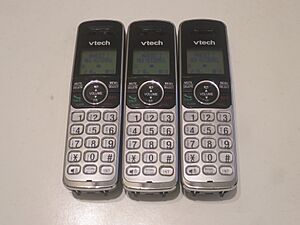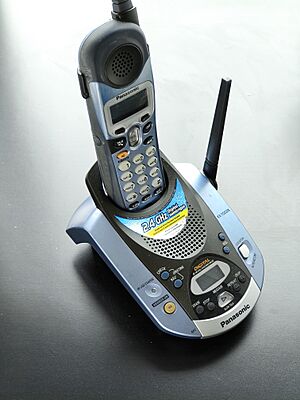Cordless telephone facts for kids
A cordless telephone is a phone with a handset you can carry around. It connects to a base station using radio waves. This base station is plugged into your home's telephone line. You can usually only use a cordless phone within your house or a short distance from the base.
Cordless phones are different from mobile phones. Mobile phones work almost anywhere, but cordless phones need their base station nearby. Newer cordless phone technologies, like DECT, are becoming more like mobile phones. They can even switch between different base stations and offer advanced features.
Unlike old-fashioned corded phones, cordless phones need mains electricity to power their base station. The handset has a rechargeable battery. When you put the handset back in its cradle, the base station recharges the battery.
Contents
The History of Cordless Phones
Early Wireless Telephones
Before cordless phones, there were "radio telephones." The first one, called MTS, started in 1946. These early systems were huge and heavy. They could cover a wide area but had very few users. A better version, IMTS, came out in 1964.
Developing the Cordless Phone
In 1963, engineers at Bell Laboratories began working on a wireless phone for homes. A team including S.M. Baer, G.C. Balzer, J.M. Brown, W.F. Clemency, M. Rosenthal, and W. Zinsmeister helped create it. By 1964, they had working models.
These early cordless phones used radio frequencies around 35 and 43 MHz. They had a low-power transmitter and a sensitive receiver. The home version looked like a regular phone, but the base station was a small box. About 50 units were tested in Boston and Phoenix.
Important Inventions and Rules
In 1966, George Sweigert applied for a patent for a "full duplex wireless communications apparatus." This meant both people could talk and listen at the same time. He got the patent in 1969. Sweigert wanted to make battlefield communication easier for soldiers.
At that time, phone companies like AT&T didn't let people connect their own devices to phone lines. Most phones were made by AT&T's company, Western Electric. But a device called the Carterfone helped change this rule. In 1968, the government decided that people could connect their own equipment to phone lines.
In 1977, Douglas G. Talley and L Duane Gregory patented a cordless phone system. It had a base station connected to the phone line and a small, portable handset. This handset had a transmitter, receiver, and controls, all powered by a rechargeable battery.
Cordless Phones Become Popular
Cordless phones became very popular in homes and workplaces in the early 1980s. In the United States, sales jumped from 50,000 in 1980 to 1 million in 1982. People loved how convenient and portable they were. However, some worried that others could easily listen in on their conversations.
In 1994, digital cordless phones came out, using the 900 MHz frequency. These new phones offered clearer sound and were more secure. Their signals could also go through walls better. In 1995, spread spectrum technology was added. This made conversations even more private and reduced interference.
Cordless Phone Frequencies
Frequencies in the United States
In the United States, the Federal Communications Commission (FCC) has set aside several frequency bands for cordless phones:
- 1.7 MHz (used by very old phones, now mostly obsolete)
- 27 MHz (near Citizens Band radio, also older)
- 43–50 MHz (popular in the 1990s, but signals are easy to pick up)
- 900 MHz (introduced in 1993, offered better quality)
- 1.9 GHz (used by DECT 6.0 phones, allocated in 2005)
- 2.4 GHz (allocated in 1998, shared with Wi-Fi and Bluetooth)
- 5.8 GHz (allocated in 2003, also shared with other devices)
Older frequencies like 1.7 MHz and 43-50 MHz are not used much anymore. This is because newer phones use higher frequencies. Some very old 1.7 MHz phones could be heard on AM radios!
900 MHz phones are still common. They have shorter antennas and more channels. Digital 900 MHz phones are harder to eavesdrop on. Newer Digital Spread Spectrum (DSS) phones spread their signal over many frequencies. This makes them very private and resistant to interference. The FCC allows DSS phones to transmit with more power, giving them a longer range.
Most new cordless phones in the US use DECT 6.0 on the 1.9 GHz band. This band is reserved just for phones, so there's less interference. However, many older phones still use 900 MHz, 2.4 GHz, and 5.8 GHz. These bands can get crowded with Wi-Fi and Bluetooth devices.
Frequencies Outside the United States
In Europe and most other parts of the world, the 1.9 GHz (1880–1900 MHz) band is used for the DECT phone standard. DECT is now the most common cordless phone standard globally, except for North America.
Cordless Phone Performance
Most cordless phones today use digital technology. This helps provide clear sound and makes it harder for others to listen in. Many cordless phone systems allow you to connect several handsets to one base station. This means multiple people can use different handsets at the same time. You can even have conference calls.
Manufacturers often say that higher frequencies mean better sound and range. But in reality, many things affect quality. These include signal strength, antenna quality, how the signal is sent, and local interference.
Regular phone lines (called "POTS") are designed for clear voice calls. They have a limited bandwidth (about 3.6 kHz). This is enough for voices but not for all sounds humans can hear. Cordless phones usually don't sound quite as good as a high-quality wired phone. This is due to things like:
- Sidetone: hearing your own voice in the speaker.
- A small amount of background noise from the phone system itself.
- A slightly limited frequency range.
Most manufacturers claim a range of about 30 m (100 ft) for their 2.4 GHz and 5.8 GHz phones. However, cheaper models might not reach this far.
Higher frequencies can also have problems. The 900 MHz, 2.4 GHz, and 5.8 GHz bands are used by many other devices. These include baby monitors, microwave ovens, Bluetooth devices, and wireless LAN (Wi-Fi). This means your cordless phone might get interference from these devices, or even cause interference itself.
The newer 1.9 GHz band is reserved for DECT phones. This helps them avoid interference from other devices that use the 900 MHz, 2.4 GHz, and 5.8 GHz bands.
Cordless Phone Security
Many older analog cordless phone signals could be easily picked up by a radio scanner. This meant anyone nearby could listen to your conversations. While some analog models are still made, modern digital technology helps keep your calls private.
Digital Spread Spectrum (DSS) technology makes calls more secure. It spreads the audio signal over a wide range of frequencies in a random way. To a simple scanner, a DSS signal just sounds like bursts of noise. Only the correct base unit can decode the signal. This makes it very hard for others to listen in. Some digital systems even encrypt (scramble) the signal for extra security.
Roaming Cordless Handsets
Some special cordless phone handsets can "roam." This means they are not tied to just one base station. They use digital technologies like DECT or Wi-Fi. They connect to a wireless access point or base station that uses the same technology. If you have a Voice over IP (VoIP) service, these phones can use your internet connection to make calls.
Health and Safety of Cordless Phones
Unlike wired phones, which get power from the phone company, cordless phone base stations need electricity. If there's a power outage, your cordless phone won't work. However, a traditional wired phone might still work during a power cut.
See also
- Carterfone
- Fixed-Mobile Convergence Alliance
- Personal Handy-phone System (PHS) in Japan and China
- Spread spectrum




